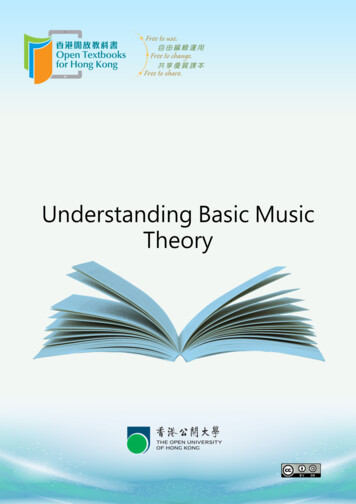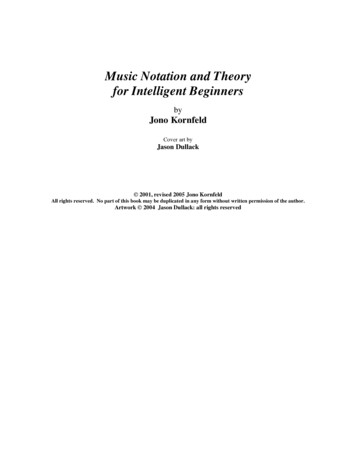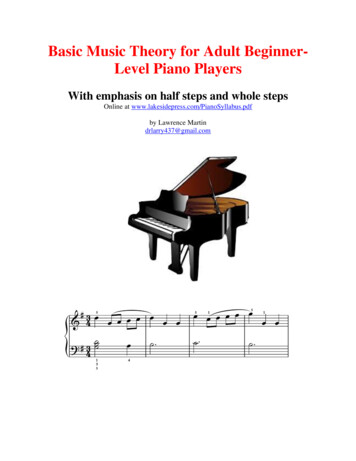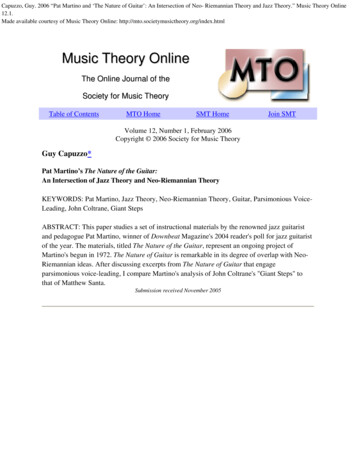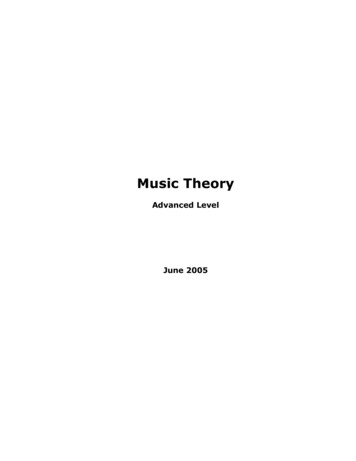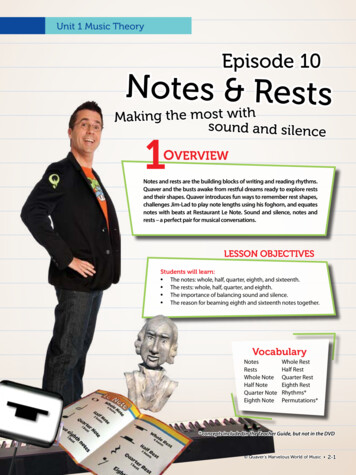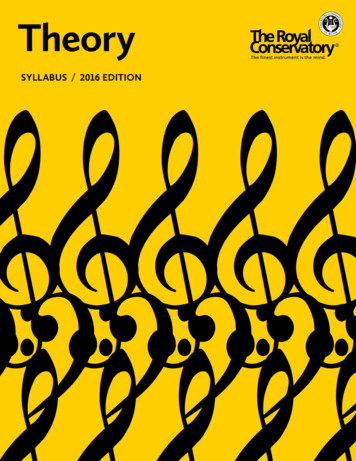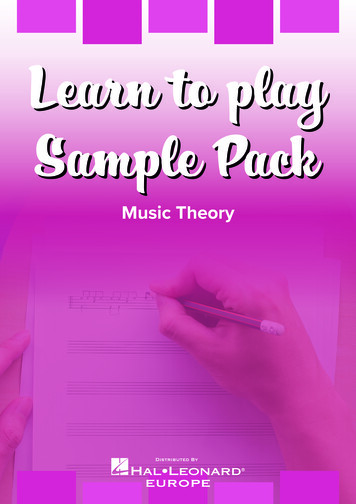
Transcription
Music Theory
Music TheoryOne of the few silver linings of these difficult times is a bit more time and inclination to take upa new skill or improve on an old one. Since lock down there has been a huge uptake in musicmaking in the home and across the internet.For beginners or those returning to an instrument after some time off, ‘Learn To Play SamplePacks’ present FREE content from some of the most popular tuition books on the market,distributed by Hal Leonard Europe. From tried-and-tested methods that have sold hundreds ofthousands of copies, to fresh new learning approaches, each Sample Pack includes introductorylessons to help you or your child get off to the perfect start.Knowing the basics of Music Theory makes it much easier to learn new pieces, and with somuch fantastic material out there, is also easy to teach yourself. It’s also a skill we could all dowith improving, whatever level of musicianship we have achieved. With pre-grades resourcesall the way through to Grade 8, there’s something for everyone. Here are some of the bestmaterials on the market:How To Blitz! ABRSM TheoryCH87142Abracadabra Beginning Theory9781472923592Rockschool Popular Music Theory WorkbooksRSK011503Step Up To GCSE MusicRHG4202 Introduction
Reasons to pick this method Arguably the most accessible and enjoyable series for working towards musictheory exams More information, worksheets and revision exercises than any other theory textbook Features quizzes, games, multiple choice, word searches and more Focusses on the piano for easier visualisation, but can be used alongsidelearning any instrument Books for Beginner Theory to Grade 5, as well as excellent material for sight-reading, rote learning, scales and moreClick below for links tothis book and relevantmaterialThe Unofficial History of Middle COnce upon a time, music used to be written on 11 lines, like this:Middle Clives hereThe note named ‘C’ lived on the line right in the middle. It was called ‘Middle C’.Many people found it very confusing looking at 11 lines all the time, and found it even moreELPconfusing trying to find Middle C. Then one day, somebody came up with the idea of takingout the middle line, leaving two sets of five lines.Now the line forMiddle Cis invisible!MASTheory Grade 1Theory Grade 5Beginner TheorySight-ReadingBook 1This was much easier to look at! Then look what happened:The two sets of lines were moved even furtherapart; the top set was given a treble clef andGrand stavethe bottom set a bass clef, leaving space forMiddle C in between. And so the grand stavewas born!It was decided that Middle C would need its own short line, called a ‘leger line’. Middle C isalways written close to either bass or treble, never floating in between.These notes are both MiddleCs - they sound exactly thesame!Rote Repertoire7CH87142 pg1-64 aug.indd 712/12/2017 10:41How To Blitz! ABRSM Theory3
Some instruments, like the flute, are high pitched, which means they mostly play notesabove Middle C. These instruments only need a treble clef to show their notes:Middle COther instruments, like the trombone, are low pitched, which means they mostly play notesbelow Middle C. These instruments need a bass clef to show their notes:Middle CELPA piano has the largest range of notes of any musical instrument, so it needs a ‘grand stave’MASto show them all. You will notice that the names of the notes are the same as the firstseven letters of the alphabet, repeated over and over again:FGA BCDEFGA BCDEMiddle CFGA BCDEFGFACT: The piano keyboard has even more keys than this, but we’ve run out of room on the grandstave! Extremely high or extremely low notes are written using ‘leger lines’. (See p.22)8CH87142 pg1-64 aug.indd 84 How To Blitz! ABRSM Theory15/12/2017 15:13
Drawing Treble and Bass ClefsThe treble clef starts on the line where G lives, then winds around like this. Then it goes up and makes a loop above the staff.it intersects on the fourth lineand as it comes down(Very important!)ELPTrace these treble clefs and then draw some of your own.MASThe bass clef starts on the line where F livesbackwards ‘c’, then curls around like a, stopping just before the bottom line. Then two dots are addedeither side of the fourth line.(Also very important!)Trace and draw some bass clefs here.Here is a slightly smaller staff to write on. You’ll need to get used to this size for yourexam. Draw a whole load of treble and bass clefs!HERE’S A THOUGHT. The treble clef used to be called the G clef and the bassclef used to be called the F clef. Can you figure out why?9CH87142 pg1-64 aug.indd 912/12/2017 10:41How To Blitz! ABRSM Theory5
Reasons to pick this method Split into small chunks to take young musicians through the very basics to givethem solid foundations Perfect for use alongside the bestselling Abracadabra instrument tuition books Explains some of the technical aspects encountered in music learning, providingexercises and activities to build knowledge and confidence Has a very clear and user-friendly layout that is especially useful for youngerlearnersClick below for links tothis book and relevantmaterialThe staveMusic is written on five lines called a stave (or staff).54321!The lines are numbered 1–5, starting with the bottom line.So if we talk about the second line, for example, it will always be the second line from thebottom.Beginning TheoryPLEWriting basic notesThe Abracadabra method isavailable for a selection of string,wind and brass instrumentsMBasic notes are oval symbols that either sit on the lines or between them, like this:SATry writing a few notes like this on the staff below. Make sure that it’s easy to tellwhether the notes are on the lines or between them.You can either draw your own or trace the examples until you get the hang of it.wwwwwww46 Abracadabra Beginning Theory6683 AC Black Abra Beginning Theory Book.indd 409/03/2017 14:28FluteViolinTrumpetClarinet
Up and down the staveNotes can be written high up at the top of the stave, or low down at the bottom.The higher notes sound higher, and the lower ones sound lower.If a note is really high or low, it might need some extra lines, called ledger lines:Eledger linesSAMThe keyboardPLTry writing some high and low notes with ledger lines on the stave below.Even if you don’t play the piano, the keyboard is a really useful way of understandingnotes and other elements of music theory.!Notice that all the white keys are named after the first seven letters of the alphabet,A–G.The black keys are arranged in repeating groups of two and three. This should help youto remember which white keys are which.C D E F G A B C D E F G A B CLOWERHIGHER56683 AC Black Abra Beginning Theory Book.indd 509/03/2017 14:28Abracadabra Beginning Theory7
Adding the clefsA symbol called a clef is drawn at the beginning of every stave. The most common clefsare the treble clef and the bass clef. Let’s have a go at drawing them.Treble clefThe treble clef is based on a spirally curl around the second line of the stave.Make a loop, bringing theline back down:24Now bring the line upabove the stave, like theneck of a swan:And finally go rightthrough the curl, endingwith a little tail at thebottom:PL3Start by drawing the curl:E1SAMTry tracing these treble clefs below, or use your own manuscript paper.You’ll soon get used to it!Bass clefThe bass clef is based on a curly shape that begins on the fourth line of the stave, withtwo dots added.1Draw the curl not quitethe whole height of thestave. It looks a bit like anear:2Now add two dots on theright, either side of thefourth line:Now have a go at drawing some nice smooth bass clefs yourself.66683 AC Black Abra Beginning Theory Book.indd 68 Abracadabra Beginning Theory09/03/2017 14:28
Reasons to pick this method The only theory series dedicated to popular, rock and other contemporary musicstyles Made up of two guidebooks for Grades Debut to 5, and 6 to 8, withaccompanying workbooks for each grade Suitable to support GCSE and further education studies for Music Technology Covers notation, music and band knowledge, analysis and specimen papers Assessed exams are fully accredited by UK regulators and offer UCAS points forgrades 6, 7 & 8 and exam centres all across the UK and beyondClick below for links tothis book and relevantmaterialSection 2 Popular Music HarmonyScales Identifying scale intervalsœ1. Write ‘T’ in boxes between notes that are a Tone apart, and write ‘S’ in boxes between notes that are a Semitone apart:?œ§œ§œ§œ§œ§œœ§§2. Write ‘T’ in boxes between notes that are a Tone apart, and write ‘S’ in boxes between notes that are a Semitone apart:&#§§§ELP§§§§Debut to Grade 5Grades 6 to 8WorkbookDebutWorkbookGrade 53. Write ‘T’ in boxes between notes that are a Tone apart, and write ‘S’ in boxes between notes that are a Semitone apart:&MAS§§Scales Writing scales with accidentals§§§§§1. Using whole notes, write a one-octave ascending scale of G major. Do not use a key signature; instead, add accidentals ifthey are needed:?Popular Music Theory – Debut2. Using whole notes, write a one-octave descending scale of G major. Do not use a key signature; instead, add accidentals ifthey are needed:18&3. Using whole notes, write a one-octave ascending scale of C major. Do not use a key signature; instead, add accidentals ifthey are needed:&RSK011503 TheoryWB Debut.indd 18WorkbookGrade 8Rockschool Popular Music Theory Workbooks24/10/2019 12:559
Section 2 Popular Music HarmonyChords Basic chord knowledge1. How many notes are needed to create a basic major chord? (Tick one box)§1 §2 §3 §4 §5 §6 §7 §82. Circle the notes of the C major chord:ABCDEFGAELP3. Write out the letter names of the notes in a G major chord:Your answer:4. Circle the major chord that shares its name with the key indicated by the key signature and clef. Finally, add the chordname on the line below the stave:MAS#& . Add the notes of a G major chord to the left stave, and the notes of a C major chord to the right stave. Pay carefulattention to the clef in each case. Finally, below each stave, write down the names of the notes used in each chord:&Popular Music Theory – Debut?#22RSK011503 TheoryWB Debut.indd 2210 Rockschool Popular Music Theory Workbooks24/10/2019 12:55
Section 3 Band KnowledgePart 1 Identification DrumsThe following three questions refer to the labelled image of adrum kit on the right:DCA1. Which letter corresponds to the hi-hat?BYour answer:E2. Which letter corresponds to the snare drum?Your answer:ELP3. Which letter corresponds to the bass drum?Your answer:FMASThe following four statements below form the options for the three questions that follow:A) It is the largest drum in a standard drum kit.B) It consists of two cymbals mounted on a stand, controlled by a foot pedal.C) In a standard kit, it is always positioned between the drummer’s knees.D) This is a large floor-mounted drum positioned to the drummer’s side.4. Which of the statements above best describes the snare drum? (Tick one box)§A §B §C §D5. Which of the statements above best describes the bass drum? (Tick one box)§A §B §C §D6. Which of the statements above best describes the hi-hat? (Tick one box)Popular Music Theory – Debut§A §B §C §DTrue or false:7. The bass drum produces the lowest sound of any drum in the drum kit:8. The snare drum and bass drum are joined together:9. The hi-hat has a pedal at the bottom of the stand on which it is mounted:§ True § False§ True § False§ True § False24RSK011503 TheoryWB Debut.indd 2424/10/2019 12:55Rockschool Popular Music Theory Workbooks11
Reasons to pick this method As well as an excellent way to get up to speed with the requirements for GCSEmusic, this book is also useful for brushing up on the important theory skills Perfect for young musicians who aspire to complement their instrumental studieswith academic qualifications Provides 14 sessions that can be tackled one-per-day for a fortnight’s ‘crash-course’ in the holidays, or spaced out over a school term Contains regular tests to ensure full understanding of each topicSession 39StemTailNote headTIME VALUESTime valuesThe length of a note is called its time value and is shown bythe shape of the note. So far in this book we have used onlya semibreve (whole note), which has a hollow note head ( ).Other notes may have stems and tails, as shown left.wClick below for links tothis book and relevantmaterialIn music, a silence (called a rest) can be just as important as a note.For every note there is a rest of the same length. In the table below,the English terms for time values are shown in bold and their widelyused American equivalents are shown in brackets.NameLengthNoteSemibreve(whole note)4 beatswMinim(half note)2 beatsorCrotchet(quarter note)1 beator/2 beatorQuaver(eighth note)1ELPMASSemiquaver(16th note)1Demisemiquaver(32nd note)1/4 beat/8 beatRestStep Up To GCSEMusicMore GCSE resourcesfrom Rhinegold EducationororNotes on and above the middle line ofthe stave normally have stems that godown from the left of the note head.Notes below the middle line of the stavenormally have stems that go up from theright of the note head.STEP UPSemibreve and minimrests look very similar.To remember thedifference, think of atwo-beat rest as lightenough to sit on aline, while the longer(‘heavier’) four-beat restflops down below a line.12 Step Up To GCSE MusicRHG420 Step Up To GCSE 72pp Book v10.indd 9Edexcel GCSE MusicStudy GuideAQA GCSE MusicStudy GuideOCR GCSE MusicStudy GuideGCSE MusicCompositionWorkbookTails of short notes are always to theright of the stem, whether the stem goesup or down.Rests should be positioned vertically on the stave as shown in thetable above. Semibreve rests must hang from the fourth line up andminim rests must sit on the middle line.The ‘hooks’ of a rest symbol always sit in spaces on the stave.The number of hooks is the same as the number of tails on a noteof the same length. For instance, a semiquaver
thousands of copies, to fresh new learning approaches, each Sample Pack includes introductory lessons to help you or your child get off to the perfect start. Knowing the basics of Music Theory makes it much easier to learn new pieces, and with so much fantastic material out there, is also easy to teach yourself. It’s also a skill we could all do with improving, whatever level of musicianship .


